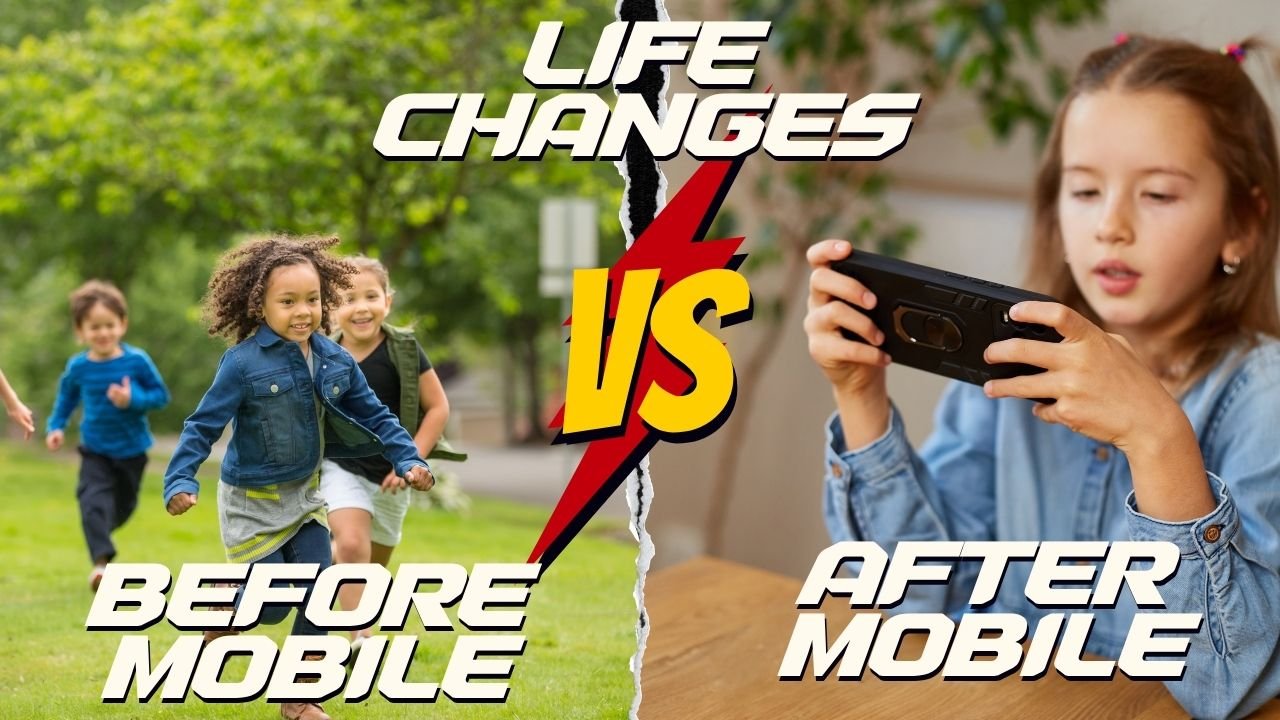Life Before And After Mobile Phones
There are lot of changes in life before and after mobile phones.
🕰️ Introduction
Hi there! Let’s take a journey back in time, before mobile phones existed—and then jump into today’s mobile era, where kids often stay indoors playing with screens instead of running outside. We’ll talk about the good and not-so-good sides of both times, share easy examples, and give parents helpful ideas to find a healthy balance.
1. Life Before Mobile Phones 📞🚫
How it felt: Imagine kids riding bikes without checking a map, building forts in the grass, telling ghost stories around a daisy chain, singing songs together—all without any screens.
✅ Advantages
-
Free outdoor play helped kids grow strong, develop balance, and stay healthy.
-
Face-to-face talking built listening, sharing, and friendship skills.
-
Imagination soared—sticks became swords, mud turned into pies, and a tree was a castle.
-
No screen distractions meant kids were fully focused on simple senses: a breeze, laughter, birdsong.

❌ Disadvantages
-
Planning took time—calling home from a landline, or using notes, could take hours to meet friends.
-
Parents worried about safety—kids couldn’t be reached in emergencies.
-
Fewer learning tools—research meant asking teachers or visiting libraries.
2. Life After Mobile Phones 📱
Things changed when mobile phones arrived in every pocket. Even younger kids now spend much of their free time on touchscreens or in chat groups.
📵 What changed?
-
More screen time than playtime. Some children now spend 6–8 hours a day on screens. In a study over half of kids aged 6–14 spent more than seven hours per weekday on devices—and 68.8 % of those kids had almost no physical activity that day.
-
Less sleep. Every extra hour on phone or tablet was linked to 11 minutes less sleep on average—and worse sleep quality overall.
-
More attention and behavior problems. Five-year-olds with high screen use showed signs of impulsivity, hyperactivity, and difficulty focusing—in studies from Finland.
-
At school, kids arrive under-prepared. Many now can’t hold a pencil or sit upright when they start school—experts say long phone use is a cause.
-
Less outdoor play. Since the 1980s, unstructured outdoor play has dropped sharply, and experts warn this harms motor skill and social growth.

✅ Advantages
-
Instant safety and contact. Parents can reach kids anytime—for example, send a text or check-in if plans change.
-
Access to learning right away. Educational apps and fun tools (like “learn language with Duolingo” or “science games”) help children explore at home. Even in schools, teachers now use apps to make lessons more fun.
-
Global friendships. Kids can talk or play online with friends or cousins far away—even in real time through video chat.
❌ Disadvantages
-
Less body movement. Kids become more sedentary—sitting still for long hours. This leads to a higher risk of obesity and poor health.
-
Mood and anxiety issues. Excessive screen time—especially on social media—is linked to poor self‑esteem, anxiety, and depression, especially in teenage girls.
-
Less family connection face‑to‑face. Even when sitting together, each person may be scrolling on a device. This is sometimes called phubbing, and it weakens real connection.
-
Less parent–child talk. Kids spend less time chatting verbally at home or during meals—experts say this slows language and social skill development.
3. Quick Comparison Table
| Area | Before Mobile Phones | After Mobile Phones |
|---|---|---|
| Play Style | Outdoor, free‑form, imaginative | Screen‑based, guided, indoor |
| Social Time | In-person face-to-face play | Chat, social media, videos |
| Learning & Info | Books, school, exploring | Apps, internet, video streams |
| Family Connection | Mealtime talks, joint activities | Screens distract during shared time |
| Health & Movement | Active: much walking, running | More sitting, less sleep, worse eyesight |
| Safety & Communication | Harder to inform quickly | Instant calls, GPS, apps |
4. Why It Matters: Facts and Guidelines
-
Two‑hour screen limit: A UK study found that children watching TV or using screens for more than two hours a day had a higher risk of emotional or peer problems—even if they exercised well another time that day.
-
Global health advice: The World Health Organization says kids under 2 should have no screen time, kids aged 2–5 no more than 1 hour, and ages 6–12 no more than 2 hours of non-educational screen use per day.
-
Sleep and movement link: Children who use mobile for many hours are nearly twice as likely to have poor sleep or skip active play even by midday.
-
Mental health warning: Recent worldwide data (from over two million people in 163 countries) shows smartphone use under age 13 is strongly tied to poor sleep, cyberbullying, low self-worth, and even suicidal thoughts in some cases.
5. 4 Tips to Balance Life After Mobile Phones
🎯 Tip 1: Set clear screen limits
Use WHO or local guidelines:
-
2–5 years: max 1 hour/day
-
6–12 years: max 2 hours/day
-
Teens: max 3 hours/day (non‑educational).
🌱 Tip 2: Create screen-free zones
No phones at dinner or one hour before bedtime. This helps family talk and improve sleep.
🚴 Tip 3: Schedule active play time
Plan walks, sports, obstacle games, or family bike rides each day—or at least 30 minutes indoors moving together (like dance or hopscotch).
🧑🏫 Tip 4: Choose good screen time
Limit passive scrolling. Prefer:
-
Learning apps with puzzles or DIY videos
-
Video calls with family abroad
-
Kids‑safe tech or parental-controlled devices that guide content gradually.
🤝 Bonus Tip: Be a good digital role model
If parents put phones away during playtime or meals, kids follow. Turn your own screen time into a conversation opportunity.
6. Final Thoughts
Remember this: life before mobile phones was slower, creative, and built on face-to-face talk—but planning was harder and kids couldn’t be helped during emergencies. After mobile phones arrived, life became faster and more connected, with more learning tools—but also more sitting, social stress, and silent dinner tables.
Neither world is perfect alone. But mixing both worlds with rules, planned play, and mindful phone use can give kids the best of both worlds—healthy bodies, strong minds, and good habits.
Want tiny games, play ideas, or fun offline family challenges to try this week? Happy to share!











